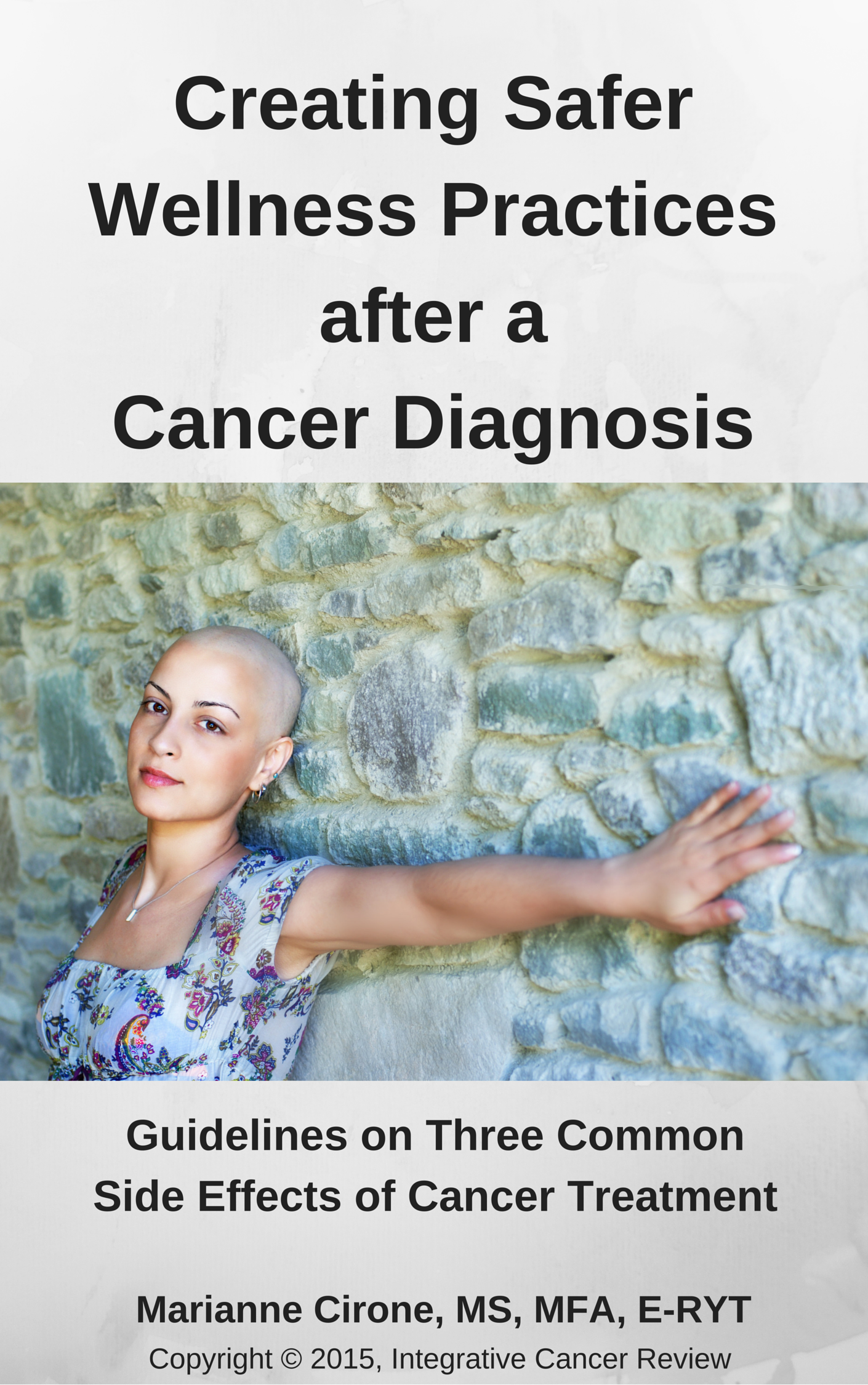
Yoga Poses & Practices: What’s Best for People with Cancer?
A few decades ago, many people in the West hadn’t heard of the word “yoga” or perhaps, just imagined a swami twisted into a pretzel. Now, however, nowadays yoga is common and in some places, it seems that there are yoga studios on every corner.
Yoga as a “therapy” is becoming more widely promoted and even mainstream medical publications are featuring randomized, controlled trials on the benefits of yoga for patient populations. In the past years, many yoga studies, such as the ones published in the Journal of Clinical Oncology, have specifically shown the benefits of yoga for people diagnosed with cancer, such as helping fatigue, inflammation, diurnal cortisol rhythms and overall well-being.
These trends now bring up questions in terms of how to best bring yoga (and other complementary therapies) to people who can benefit from it. Some experts say that it takes ten years from the time something is proven in research to becoming part of a clinical practice. So, now that “yoga” is getting the thumbs up as a part of an overall cancer treatment program in many instances, what is next?
A central issue in determining how to proceed with yoga as a complementary cancer care modality is that “yoga” is a term that encompasses an incredibly vast and heterogeneous array of practices and philosophies. Many leading yoga “experts” have diverse backgrounds and disagree with each other on how to practice yoga (sometimes vehemently so!). The information from yoga research studies may not be as enlightening as we’d like either. In the published study results, often there is no more than a paragraph on the styles and practices of yoga that were practiced, and where there is a description, there were usually a wide array of techniques practiced. So how do know which specific practices are indicated, and how do we take that information to the next level, sort out the best practices, and bring it to the people who can benefit?
Research in Yoga for Cancer Care
One suggestion is to progress to “dismantling trials” in yoga for cancer care which specific aspects of a practice are separated and studied. But, while this could shed light on specific techniques, yoga and Ayurveda are larger systems, so a question becomes, would the synergistic effects the practices be lost if they are dismantled? The other issue is that many approaches to yoga and Ayurveda are ideally individualized practices, so the question is: where can we make general guidelines as to yoga practices for cancer survivors and where do the approaches need to be individualized? There is clearly no one “right” answer, but as we make an open inquiry, we can move the conversation into a direction that supports positive action. The following provides an overview of three of the main issues that need to be considered in determining what are the best yoga poses and practices for cancer survivors.
Safety in Yoga for Cancer Care
The creed, “first, do no harm,” is associated with physicians and the Hippocratic Oath. This pledge for safety should also apply to complementary practices such as yoga. The yoga practices used for people with a cancer diagnosis should be as safe as possible for any conditions of cancer, cancer treatment, and any co-morbid conditions, while being robust enough to be effective for the benefits sought.
While nothing is without any risk, a certain level of caution is mandatory in order to maximize safety in yoga for cancer care. Due diligence is using the best available information in a reasonable way, and doing absolutely nothing has its own risks. We have heard the risks of excessive sedentary lifestyles, and the esteemed yoga teacher, Gabriel Halpern, often says, “Doing too much in yoga can be a form of harming yourself, but so can doing too little.”
That said, it is important to have awareness of risks related to yoga practice that apply to individuals specifically and in general after a cancer diagnosis. During and after cancer treatment, cancer patients and survivors should know about which of their treatments could put them at risk for side effects, and learn how to appropriate modify poses. For example, patients who have lymph nodes damaged or removed need to know about the recommended guidelines for reducing lymphedema risk, including those that would pertain to exercise or yoga practices.
Ideally, each person diagnosed with cancer, their yoga teacher/therapist and their medical team members should collaborate and share information as much as possible. Physicians should be aware of the side effects of treatment, provide diagnostic testing as indicated and inform the patients on what guidelines to follow. The information provided by the physician on the medical concerns will help the student and teacher know how to appropriately modify a yoga practice.
Yoga teachers need to be educated on the common side effects of cancer treatment and what modifications would need to be made for these. For example, teachers should know how to reduce risk of compression fractures in the case of bone loss or weakening, a common side of many cancer treatments, by avoiding or using caution with rounding of the spine. Yoga teachers and therapists also need to be aware of their scope of practice and work within the legal and ethical guidelines as well.
The student/survivor should always have as much knowledge and empowerment as possible. They should follow the practice of “ahimsa” or “non-harming” in order to stay in control of what they do or don’t decide to do in a yoga practice.
Effectiveness in Yoga for Cancer Care
After safety, the second key principle in guiding a yoga for a cancer practice is knowing that the type of yoga practice used is effective in achieving the desired outcomes. Knowing the most important objectives of a yoga or other complementary practice will impact the choices made in designing effective practices for people diagnosed with cancer. Here is where yoga teachers can utilize guidance from researchers and from Ayurvedic and yogic experts as to what is the priority focus for a practice and how best to achieve that objective. For example, research correlates abnormal diurnal cortisol rhythms and negative health effects, including earlier mortality in cancer survivors. So, since we know that yoga can positively influence diurnal cortisol rhythms, would improving those become a top priority in designing our yoga lesson plans? And if so, what would be the best constellation of techniques to do that? This is where the marriage of research and yoga will be critical. Ayurvedic practitioners have wisdom related to more subtle aspects of treatment side effects and will have guidance relative to that.
Yoga also has been shown to hold unique benefits for certain “hard to treat” medical symptoms, such as fatigue, insomnia and inflammation. Many standard medical treatments for conditions such as these bring even more side effects. Thus, yoga could have a key role in an overall cancer treatment plan that seeks to maximize healing while reducing side effects. But yoga teachers and therapists need to have a good understanding of what these symptoms are and which yoga techniques best address them. By joining modern research with yogic wisdom, the optimal yoga and complementary health plans can be designed.
Accessibility in Yoga for Cancer Care
Access to appropriately safe and effective yoga and other complementary cancer care modalities is a major issue and is likely to increase in the near future. There are currently about 14 million people in the United States who have been diagnosed with cancer–and this number is expected to grow to 20 million in the next years. And every cancer patient has a group of family members and caregivers who is dealing with the repercussions of this disease. Creating safe and effective yoga classes that are accessible to these 20 million people and their caregivers is a key priority in order to support physical, mental/emotional and spiritual health in the cancer community. However, when looking for yoga classes that are both safe and effective for cancer survivors, accessibility is a potential issue.
Unless one is living in a larger metropolitan area with specific cancer-focused yoga classes, there may not be easy access to such classes. Even where such classes do exist, they are often held during the “off hours” for yoga studios, such as mid-day, when many people, even going through cancer treatment, are working. Yoga videos and online options may not give the personal guidance needed. Standard yoga classes may not provide the needed focus or modifications to make the classes safe or effective for cancer patients and survivors.
Cost is another potential obstacle to bringing safe and effective yoga to cancer survivors. Yoga is an extremely cost effective modality relative to high tech medical interventions, many pharmaceuticals and other modalities, especially for some of those harder to treat symptoms like fatigue. However, it is rarely covered by insurance. It is most likely an out of pocket expense, which could limit the access to classes for many people, particularly those undergoing cancer treatment.
Another major barrier to access can be the availability of yoga teachers who are trained to teach people diagnosed with cancer. Teaching yoga for people with cancer is mostly a labor of love by yoga teachers, many of whom are unpaid or underpaid relative to market value for these very specialized classes. Many of those who have the heart for such work don’t have the funds to afford most of the training programs that exist today. Much of the cancer-specific yoga training is prohibitively expensive for many teachers who would like to teach to this population and the lack of economic sustainability limits the pool of qualified teachers. Teachers who do spend the dollars for high priced trainings may encounter other economic repercussions in recouping the costs invested in education. In order to increase the pool of qualified teachers and reduce the financial barriers to working with this community, it will be essential to make quality training affordable and accessible as well.
Upcoming Articles on Cancer-Modified Yoga Practices
By working together as a community for a single mission, we can increase safety, effectiveness and accessibility to yoga and other practices to potentially alleviate pain and unnecessary suffering amongst millions of people dealing with a cancer diagnosis.
A series of articles featuring expert and research-guided practices for yoga for cancer care will be coming in the near future. Join our mailing list now and stay informed of updates!
See more on Yoga Poses & Practices:
- Using Mudras in Cancer Recovery
- Q&A with Rita Meier on Yoga for the Pelvic Floor
- Yoga Nidra: The Practice of ‘Yogic Sleep’
- The Elements of Yoga Nidra













